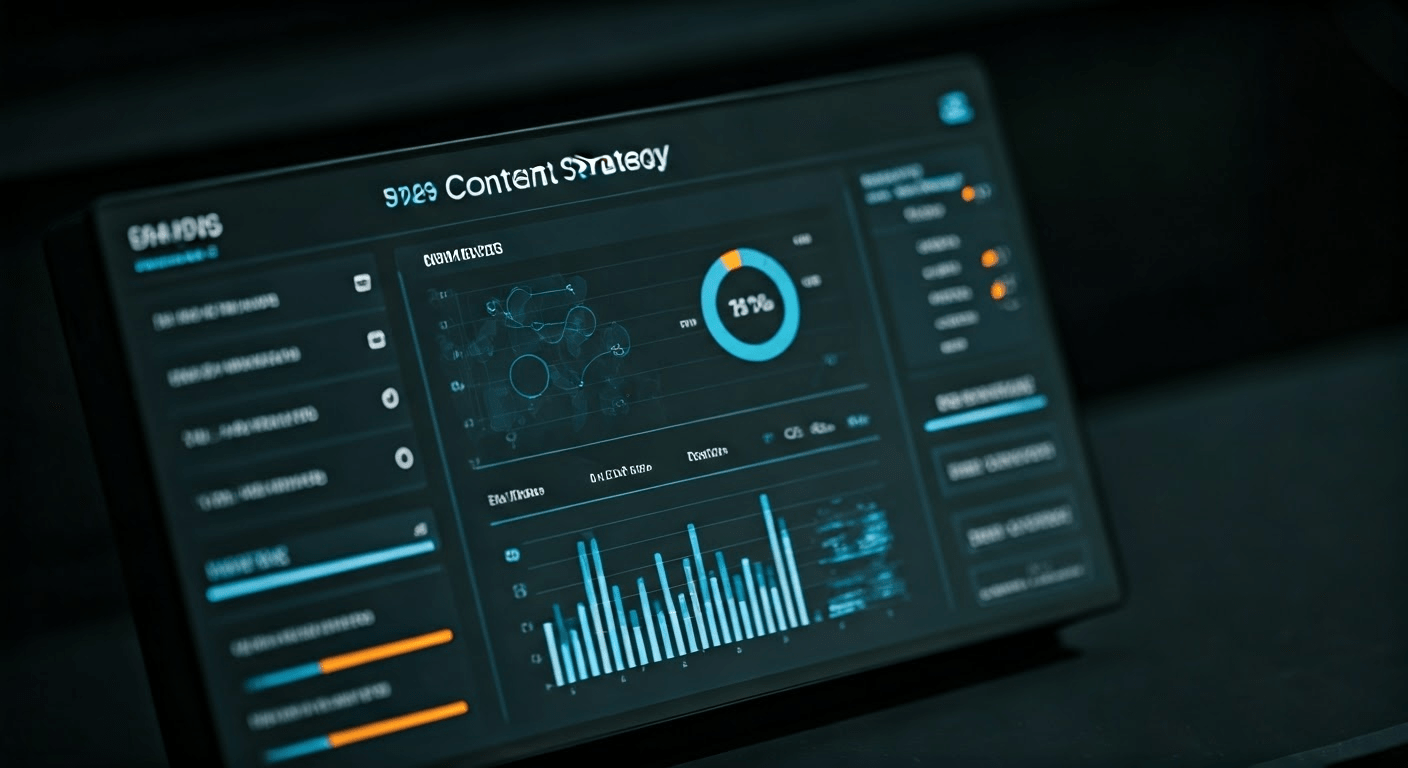
Key Highlights
- A content strategy is a plan to create, manage, and improve website content. It should align with your business goals and address user needs.
- You need to know your audience. Look at the content you have, study your competitors, and see what is missing.
- A good content strategy offers different types of content, focuses on SEO, and keeps a consistent brand voice.
- It is important to share your content through social media, email, and other channels. This helps you connect with more people.
- To succeed over time, you must regularly check how your content performs and change it if needed.
Introduction
In today’s online world, it’s important to have a clear plan for your website content to succeed. It’s not just enough to add text to your site. You need to plan everything carefully to make sure users have a good experience and that your business goals are met. This simple guide will help you understand the key parts of creating a strong content strategy. A good strategy will attract your target audience and bring real results.
Understanding the Fundamentals of Website Content Strategy

Think of your website like a busy city. Your content strategy is like a city planner. It makes sure that every piece of content has a clear purpose and a specific spot. It connects well with your target audience. The goal is to create a smooth and engaging online experience. This experience should grab attention, build trust, and encourage people to take action.
A smart way to handle your posts is to think about everything carefully. First, you need to understand who your audience is and what goals you want for your business. It’s also helpful to look at what your competitors are doing and review your own results. This is a process of planning, creating, sharing, and improving content to reach specific goals that you can measure.
Defining Content Strategy and Its Importance
A content strategy is basically a simple plan. It links your web content to your main business goals. This plan tells you what content to create, who will benefit from it, and how it can help you meet your business objectives. A good strategy gives you clear instructions and keeps everything organized. It serves as a guide for all your content creation.
A good content strategy is important for many reasons. First, it makes sure your content targets your audience and meets their needs. Second, it helps you maintain a consistent brand voice and message across all your platforms.
Having a plan helps you see how well your content is doing. This shows you what works best. It also makes sure you get the most from what you spend on content.
The Difference Between Content Strategy, Content Marketing, and Content Writing
I understand that these terms can be confusing. But, knowing what makes them different is important. A content strategy is your main plan for working with content. It explains what your content is and why you create it.
Content marketing is all about the “how.” It focuses on various ways of sharing your content. It also helps you connect with your target audience. You can do this through social media marketing, email marketing, and SEO.
Content writing is all about creating content. This can include blog posts, text for websites, or social media updates. Content writing turns your ideas into something real. In simple words, your strategy guides your marketing, and your writing helps it succeed.
Setting Your Website’s Content Goals

Before you make content, set clear goals first. Think about what you want to achieve. Do you want to make more people aware of your brand? Are you trying to get new leads, increase sales, or keep customers coming back?
By figuring out your goals early, you can create a content plan. This will also let you see how you are doing. It will show the benefits of your content efforts.
Aligning Content Strategy with Business Objectives
Your content plan should not operate alone. It needs to link to your main business goals to make a real impact. This connection begins with knowing what your business wants to achieve. After that, you can figure out how your content can help reach those goals.
If you want more people to know about your business, your content strategy can make a difference. You can write helpful blog posts that others will want to share. You can also post interesting updates on social media. By offering useful resources for download, you can show that your brand is a top choice in your area.
When you connect your content plan to your marketing goals and business objectives, each piece of content you make helps you succeed.
Identifying Target Audience and User Needs
Creating content without knowing your target audience is like throwing darts in the dark. You must think about who you want to reach. What do they like? What problems do they face? What are their goals?
When you understand your target audience and what they want, you can make better content for them. This allows you to fix their problems and give good solutions. A clear approach makes it more likely that people will read, share, and engage with your content.
Good content is useful and connects nicely with your audience. When you focus on user needs, you gain their trust and build your credibility. This helps you create better relationships with your target market.
Key Components of an Effective Content Strategy

An effective content strategy has several important parts. Each part helps create, share, and improve content that connects with people. Here are some key parts of an effective content strategy:
You should do a complete content audit. This will help you check what your competitors are doing and find ways to improve your content. These steps will help you create a good and successful content marketing plan.
Content Auditing: Taking Stock of What You Have
Before you create new content, you should look at what you have. A content audit is when you review your existing content on all platforms. This process helps you understand what is working well, what is not effective, and any areas that need improvement.
A content audit usually follows these steps:
- Gather all your content: Collect website pages, blog posts, social media updates, and other related materials.
- See how it’s performing: Use tools to look at page views, bounce rates, time on the page, and conversions.
- Find what needs improvement: Determine which content needs updates, merging, or removal.
By looking at your current content closely, you can find easy fixes. You can take out anything that repeats. This will help you make better choices for new content creation.
Competitor Analysis: Learning from Others in Your Space
Keeping an eye on your competition is important to stay ahead online. Competitor analysis helps you understand how your rivals approach their content strategy. You should identify what they do well and where they struggle. It’s also good to find any gaps in their content marketing efforts.
When you look at how your competitors create their content, you can learn some important things, like:
- Popular topics and keywords: Check their best content. This will show you which keywords and themes are most important.
- Content formats and channels: Find out what types of content they make and where they share it.
- Audience engagement: Watch how the audience interacts with their content. This can help you learn useful strategies.
Competitor analysis is not only about imitating what others are doing. It is about understanding the market trends. You can find effective ways to improve your own work. This process can help you make better content. It can also set your brand apart from the competition.
Content Gap Analysis: Finding Your Unique Value Proposition
A content gap analysis helps you understand your competitors’ work. It shows you where your audience’s needs are not being met by current content, whether from your brand or others. This information reveals a chance for you to create unique content. This could help you stand out from the competition by being more useful to your audience.
- Find out what topics you want to discuss.
- See what your competitors have done.
- Find the keywords they use.
- Check what content is missing in your field.
- Make a list of topics you can add.
- Look at how you can make your current content better.
- Focus on areas that will bring in more visitors.
- Update your content often to keep it fresh and useful.
- What questions do your target customers ask online?
- What problems do they have that your competitors do not solve?
- Are there any new trends or changes in the industry that provide opportunities for more content?
By adding details to your content plan, you give useful information to your audience. This shows the skills of your brand. It creates a unique value that shines in a busy market.
Planning and Creating Content That Delivers
Now that you have a clear idea of your goals, audience, and competition, you can plan content that matches your strategy. This involves selecting the right content types, optimizing it for search engines, and maintaining consistent messages.
Creating good content takes time and effort. Keep in mind, this is an investment. If you do it correctly, you can enjoy great rewards. These rewards include increased engagement, growth for your brand, and new opportunities.
Content Types and Formats That Engage Your Audience
It is key to select the right types of content. This choice can catch the interest of your target audience. People prefer different content formats at different points in their buying journey. A good idea is to combine several types of content.
- Blog Posts: Share useful information, news, and updates about your field.
- Infographics: Show complicated details clearly and simply.
- Videos: Engage your audience with demos, tutorials, and behind-the-scenes views.
- Case Studies: Highlight successful customer stories to show how your products or services can help.
- Ebooks and White Papers: Offer detailed content to enhance your authority.
- Try different types of content.
- See what your audience enjoys the most.
- A mix of content can help fit different learning styles.
- This method keeps your audience interested.
SEO Best Practices for Content Creation
Creating great content is only part of the job. You also need to help your target audience find it. Use SEO best practices to make sure your content ranks higher in search results. This can bring organic traffic to your website.
- Remember your keywords when you make content.
- Include keywords in titles and headings.
- Use keywords naturally in your text.
- Don’t use keywords too much; it can lower your rankings.
- Think about your audience and write for them.
- Ensure your text is clear and easy to read.
- Use images, but also add text descriptions.
- Update your content often to keep it new.
- Keyword Research: Look for the words and phrases your audience uses. Do complete keyword research.
- Optimize Title Tags and Meta Descriptions: Create clear title tags and meta descriptions that include keywords. This can bring in more clicks.
- Use Internal and External Links: Add links to other pages on your site. This helps people find more information. Also, include links to trusted sources outside your site.
- Optimize for Mobile Devices: Make sure your website and content are easy to use on mobile devices. A good user experience is very important.
Using search engine optimization (SEO) techniques in your content creation can help you get noticed more. This leads to more visitors who are interested in what you offer and helps your website rank higher on search engines.
Ensuring Content Consistency and Brand Voice
Consistency is very important for building a strong brand and gaining trust from your audience. Content consistency means having a similar style, tone, and message on all your platforms. A clear brand voice is a big part of this.
- Always use a consistent style for text.
- Keep a similar tone in all your content.
- Use the same colors and fonts in your visuals.
- Ensure that images fit well with the feel of your text.
- Be clear about your brand’s voice and stay true to it.
- Update your content often to keep it fresh.
- Test everything to find out what works best for your audience.
- Create a Style Guide: Write a simple style guide. It should explain the grammar, tone, and look that your brand wants.
- Use an Editorial Calendar: An editorial calendar helps you plan and check your content. This keeps your posts coming out on time.
- Establish a Content Review Process: Set up an easy review process. This way, all content meets your brand rules before sharing.
When you keep your content consistent and use a strong brand voice, your audience will easily notice you. This practice helps to build trust and loyalty to your brand over time.
Content Distribution and Promotion Strategies
Creating great content is just one part of the process. You also need to make sure that it gets to your target audience. That is why content distribution and promotion are very important.
You can share your message through social media. Email marketing is another way to connect with more people. There are many ways to help your content reach a bigger audience and work better.
Leveraging Social Media for Content Amplification
Social media is a key tool for sharing and promoting content. When you post on sites like Facebook, Twitter, LinkedIn, and Instagram, you can connect with more people. This helps attract visitors to your website and encourages them to engage.
But just posting everywhere is not enough. Good social media marketing has to include:
- Finding Your Target Audience: See which platforms your audience uses often.
- Customizing Your Content: Change your messages and content to fit the platform you are using.
- Interacting with Your Followers: Reply to comments, answer their questions, and join in on discussions.
Being active on social media helps you connect with more people. It lets you start important talks with your audience. Changing how you share content can make a big impact.
Email Marketing as a Tool for Content Distribution
Email marketing is still a strong way to share content, even with the rise of social media. It allows you to connect with leads and create good relationships with your audience. By organizing your email list and personalizing your messages, you can send important content to different groups of subscribers.
Here are some best practices for email marketing:
- Segment Your Email List: Split your subscribers into groups. Do this based on their likes, age, or jobs.
- Personalize Your Emails: Use the names of your subscribers. Change content to fit their interests. Make sure your calls to action are aimed at them.
- Provide Value: Your emails should offer something useful. Share exclusive content, helpful tips, or special deals.
Your marketing team should see email marketing as a way to share personal content with your audience. When done right, it can boost engagement, increase sales, and build brand loyalty.
Measuring Success and Optimizing Your Content Strategy

Measuring the effectiveness of your content strategy is important. It helps you make improvements. You can use key performance indicators (KPIs) to see what your audience likes and dislikes. This gives you a clear idea of where to make changes.
Making choices using data is key for improving your content plan. It helps you get good results and reach your business objectives.
Key Performance Indicators (KPIs) for Content Strategy
- Key performance indicators (KPIs) show how good a website’s content strategy is.
- These metrics give important details about how effective and impactful the content is.
- Some common KPIs to watch are website traffic, conversion rates, average session length, bounce rates, and social engagement numbers.
- By looking at these KPIs, content teams can see how well their plans are working.
- This helps them improve their content and line it up with business objectives.
- Also, checking KPIs shows areas that need fixing and helps improve the overall strategy.
Tools and Techniques for Content Strategy Analysis
There are several tools and ways to help you understand your content strategy. These tools give you the data you need to make decisions. They include website analytics and social media management tools.
Here are some commonly used tools:
- Google Analytics: This tool gives details on website visits, user actions, and conversions.
SEMrush helps you with detailed keyword research. It also has tools that let you check your competitors and run SEO audits.
- Buzzsumo: This tool lets you see how your content performs on social media. It also helps you keep an eye on trends in your industry.
By using these tools and methods, you can learn a lot about how your audience acts. You can also find ways to make your content strategy better. This will help you continue to succeed.
Conclusion
A good content plan for your website is important for a strong online presence. You should align your content with your business goals. It’s also important to know your target audience. Share interesting content regularly to engage them. This practice will help improve your brand’s visibility and lead to better results. Don’t forget to use social media and email marketing to share your content. Keep track of key performance indicators to see how well you are doing. Always search for ways to improve your plan for the best results. If you want to enhance your website’s content, contact us for expert help. Let’s work together to boost your online presence!
Frequently Asked Questions
How Often Should You Revise Your Content Strategy?
Reviewing your content strategy is important. Your target audience can change. Market trends can shift as well. Because of this, your content strategy should also change. Check your strategy every three months at a minimum. If your business case needs it, you might want to do this more often. Use your editorial calendar to help with these updates.
Can Small Businesses Benefit from a Content Strategy?
Small businesses can gain a lot from a strong content strategy. A clear plan helps them reach their marketing goals. It makes sure their digital content attracts the right audience. This content should be engaging and provide a good user experience. A solid strategy helps them gain and keep customers.
How Does Content Strategy Impact SEO?
Content strategy is key for SEO. When you match your content with search engine optimization, you can increase your chances for organic traffic. Using effective keywords, creating clear and useful content, and designing a user-friendly website will help you rank better in search results.


